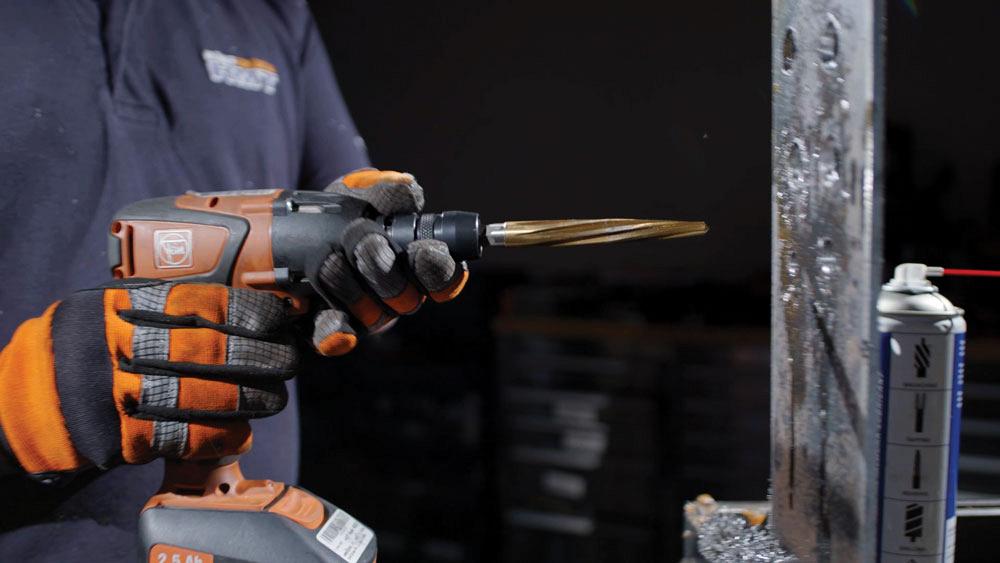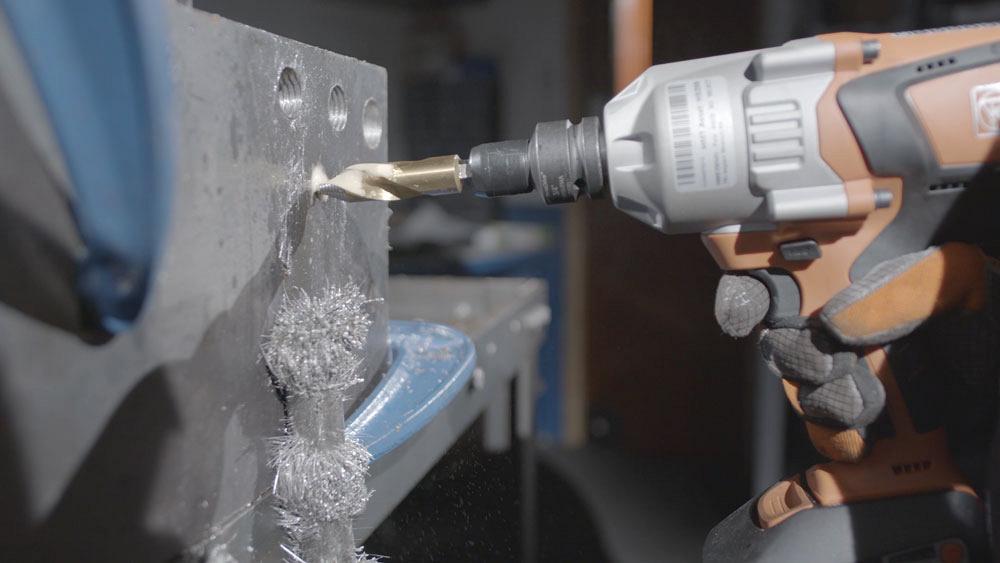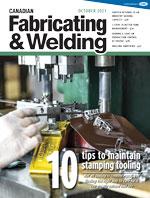Editor
- FMA
- The Fabricator
- FABTECH
- Canadian Metalworking
Drilling simplified
Adapter allows operators to ream, countersink, tap, and drill with impact wrench
- By Rob Colman
- November 3, 2021
- Article
- Fabricating

HMT’s adapter is shown in use here with a VersaDrive reamer. All VersaDrive tools have a non-slip, hex shank.
Cordless impact wrenches are popular in shops because of the power available in a small-sized tool and the freedom it creates for fastening processes at a job site. Traditionally, impact wrenches have only been able to be used for fastening and unfastening bolts; other types of power tools had to be used for drilling holes.
In recent years, however, an adapter has been designed to absorb the strong torque and impact produced by an impact wrench; this expands the range of jobs an impact wrench can handle, including reaming, countersinking, tapping, and drilling. Impact wrench drilling increases the performance of the bit into a very safe, controllable, hand-held application. Basically, you can complete a heavy-duty holemaking task with a cordless hand-held power tool.
Smart Drill Practices
When preparing to drill, fabricators should always think through a few best practice.
“Knowing the material you are drilling is very important,” said Richard Carbis, national training and product manager, FEIN Canada. “The material you are drilling into and the size of the drill bit is going to tell you the correct RPM. It will also dictate the coolant to be used. We always recommend the use of a coolant, whether it be a liquid or a paste. This will help extend tool life. When working in hardened or heat-affected materials, we recommend increasing the torque, reducing the RPM and feed rate, and using extra coolant.”
In terms of ergonomics, Carbis reminds users that consistent practices are important for quality finishes and avoiding worker fatigue.
“It’s important to apply firm and steady feed pressure throughout a cut, for instance,” he said. “It’s also critical to avoid lateral movement or tilting, which can cause damage to the cutting tool.”
The size of hole also will have an impact on your approach.
“If it’s going to be a small hole, up to a half inch, we recommend using a twist bit,” said Carbis. “Once you get holes larger than that, in thin materials we usually suggest a step drill, which will take you above a half inch very quickly. In thicker materials, we usually recommend a twist bit for blind holes and an annular cutter for through holes."
Impact Advantage
Carbis notes that when using a rotary tool to drill holes, there is a risk of injury to the user.
“When you are drilling a bigger hole especially, when a drill bit catches, it hurts your wrist and can hurt your arm,” he said. “It can also lead to repetitive strain injuries. An impact wrench, on the other hand, absorbs all that force. It also makes it easier to drill holes because of the additional torque you can get using an impact wrench.

HMT’s TurboTip product is a drill bit that steps out from six to eight steps until you get the finished drill bit diameter. It removes the need to pilot drill for a larger-diameter drill bit. Images: HMT
“Having more torque is valuable. If you use a tool with less torque and the tool jams, if you don’t have enough torque to overcome that jam, all the torque forces will transfer to the bit and it will break the bit. If the tool has more torque than required, it will always try to keep the tool turning, and it transfers the torque to the rotational forces rather than the bit.”
Impact Innovations
The VersaDrive system by Holemaker Technology (HMT) is the first modular cutting system that allows cutting tools to be used across impact wrenches and drivers as well as rotary drills like magnet drills, hand-held drills, and pillar drills.
HMT was founded by brothers Hugh and Piers Crane, who grew up in a third-generation, family-run welding and industrial supply company.
“An opportunity came up to sell that business in 2011 to a general supply house,” said Hugh. “We worked with the new owners for a while, but our expertise was always in the fabricating and welding area of the industry, and we saw opportunities in the metal drilling and cutting sector where we could really make a difference.”
The Cranes had sold cutting and drilling equipment for years and knew that there were certain common issue that hadn’t yet been addressed by other manufacturers. They launched HMT in 2014 to remedy that.
“Until our line was introduced, people didn’t think about using an impact wrench and a drill bit together,” he said. “In doing so, it turbocharges the performance of the tool in a very safe, controllable, hand-held application. Basically, you can complete a seriously heavy-duty task with a cordless, hand-held power tool. So it really is transformational for metalworkers.”
As it’s a modular system, all of the tools have a common shank design with a range of system adapters that allow the user to swap them out on a variety of different power tools.
“That creates a lot of convenience and functionality,” said Crane.
Tooling Developments
All of the system’s tooling has hexagonal shanks, which provides a non-slip grip in a drill chuck and provides more torque than a standard round-shank drill bit.
“Our company tagline is ‘Cutting tool innovations that speed up metalworking,’ and the shape of the shank on our drill bits is an example of how we’ve achieved that,” said Crane. “We increased the output of the bit itself with that design, allowing it to use higher torque, which translates into higher performance. We have a laser focus on that goal.”
Another example of time-saving innovation in the product line is the company’s TurboTip product for the VersaDrive. This is a drill bit that steps out from six to eight steps until you get the finished drill bit diameter.
“It removes the need to pilot-drill for a larger-diameter drill bit,” said Crane. “If you’re drilling a 1/2-in. hole in 1/2-in.-thick steel, you might start with a 3/16 bit, stepping up to a 5/16, 3/8, and ½ in., whereas with this bit you’re only drilling 1/16 at a time with the graduated bit. You’re cutting less material with each step, and therefore you can drill at a higher speed with less pressure. So instead of drilling the entire periphery of the hole at the maximum diameter, you’re stepping up to that finished size. That gives you very fast and very accurate drilling, particularly when you combine that with an impact wrench.”
Another innovation of HMT’s is its drill sink product, which combines a drill bit and a countersink in one tool.
“This isn’t a completely unique product, in the sense that it is used in the woodworking and precision machine tooling sectors, but there has never been a product like it in the fabricating industry where you can drill and countersink a hole in one operation. It reduces two operations into one and provides more accuracy because it is centering the countersink directly on the hole established by the drill bit.”
Crane sees more opportunities for innovation in the future as HMT grows.
“During our time in the distribution business, we often had customers asking us for tools that didn’t yet exist in the specialist metal drilling tool space,” he said. “We continue to work to fill those industry gaps.”
Editor Robert Colman can be reached at rcolman@canadianfabweld.com.
FEIN Canada, fein.com/en-ca
Holemaker Technology, holemaker-technology.com
About the Author

Rob Colman
1154 Warden Avenue
Toronto, M1R 0A1 Canada
905-235-0471
Robert Colman has worked as a writer and editor for more than 25 years, covering the needs of a variety of trades. He has been dedicated to the metalworking industry for the past 13 years, serving as editor for Metalworking Production & Purchasing (MP&P) and, since January 2016, the editor of Canadian Fabricating & Welding. He graduated with a B.A. degree from McGill University and a Master’s degree from UBC.
Related Companies
subscribe now


Keep up to date with the latest news, events, and technology for all things metal from our pair of monthly magazines written specifically for Canadian manufacturers!
Start Your Free Subscription- Industry Events
Automate 2024
- May 6 - 9, 2024
- Chicago, IL
ANCA Open House
- May 7 - 8, 2024
- Wixom, MI
17th annual Joint Open House
- May 8 - 9, 2024
- Oakville and Mississauga, ON Canada
MME Saskatoon
- May 28, 2024
- Saskatoon, SK Canada
CME's Health & Safety Symposium for Manufacturers
- May 29, 2024
- Mississauga, ON Canada




















